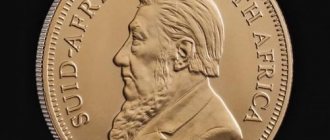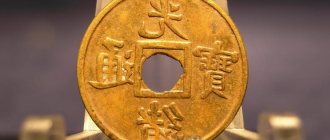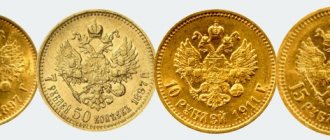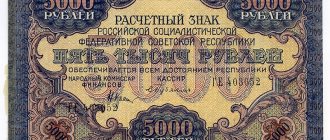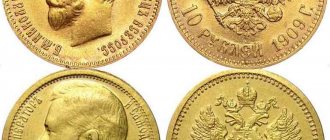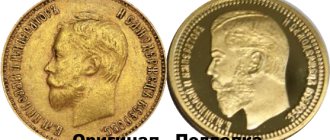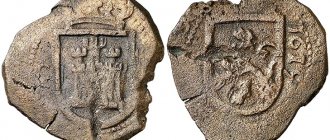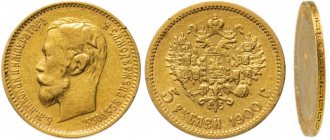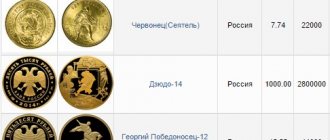California gold coins include antique, commemorative and contemporary designs that reflect and symbolize the country's rich history. The US Mint produced the first copies at the end of the 18th century, producing money of various denominations. The best sculptors and engravers of their time were brought in to create the designs, making American precious metal coins popular with collectors and investors. All American gold coins in our catalog.
History of the gold dollar
The first one-dollar coins in the United States were minted at the end of the 18th century. They were made of silver. Today, the value of one such coin is more than three million times its original denomination.
American gold dollars owe their existence to several fevers that took place in this country in the first third of the 19th century. Of course, we are talking about the so-called “gold rushes” in the states of Carolina and Georgia. The US gold dollar, despite its insignificant denomination, was of historical importance for the development of the American economy.
It is curious that the first dollar coins made of precious metal were issued on a private coinage owned by the German entrepreneur Christoph Bechtler. He posted advertisements throughout North Carolina offering to melt the mined gold into coins for a small fee. A lot of people responded. The success of this enterprise forced Congress to establish official minting of such coins at the state level.
Story
In 1792, the US Congress approved the Coin Act, according to which a bimetallic monetary system was introduced throughout the country. Before this law, private regional issues, coins of the French colonies, tokens with a portrait of Washington, coins issued before 1766 and after 1766 were in circulation. The ratio of gold to silver was 1 to 15. Anyone in the United States could go to the Mint with their own bullion and receive from it the corresponding number of coins.
Did you know? The first gold coins according to the new standard began to be minted in California in 1795. The denominations of the coins were 10, 5 and 2.5 dollars. The appearance for all samples was the same - the inscription LIBERTY and a portrait of Liberty for the obverse, the inscription UNITED STATES OF AMERICA and a bald eagle for the reverse. Jeweler Robert Scott was hired to create the design. The model for the first Liberty was the daughter of the president of the First Bank, Anna Willing Bingham. The girl had a turban on her head, so the first California gold coin was called Turban head.
In 1848, significant reserves of gold were discovered in California. The area began to fill with people mining the precious metal and sending it to the San Francisco Mint. The gold rush lasted four years. During this time, California transformed from a provincial city into a state. Coins in denominations of 1 and 20 dollars were added to circulation. Large denominations were intended for international trade. In 1853, new coins were introduced - three dollars, but they did not take root. Part of the design is by Christian Gobrecht, $20 Double Eagle was designed by William Kniss, the engraver who depicted Liberty on California gold coins in the antique style. All American gold coins in denominations of 1 Dollar and 20 Dollars in our catalog.
At the end of the 19th and beginning of the 20th centuries, the time came to change the appearance of gold coins. President Theodore Roosevelt turned to famous US sculptors and engravers. Thanks to his efforts, legendary samples of precious metal appeared, whose value today on numismatic markets reaches 7-10 million dollars. The sculptors Augustus Saint-Gaudens, Adolphe Weinman, Herman McNeil and Bela Lyon Pratt worked on the design of US coins. The appearance of the new copies has changed significantly, and the motto “IN GOD WE TRUST” has also been added to the obverse.
Antique US and California gold coins from 1907-1933:
- $20 – Saint-Gaudens Double Eagle 1907-1933;
- 10 dollars – Indian Head of Saint-Gaudens 1907-1933;
- $5 – Indian Head Bela Lyon Pratt 1908-1929;
- $2.5 – Indian Head Bela Lyon Pratt 1908-1929.
The US gold dollar, created by engraver James Longacre, was minted from 1849 to 1889. Commemorative series were issued in 1903-1905, 1917 and 1922. It was then replaced by the 1 Morgan silver dollar, the Peace dollar, and the Eisenhower dollar.
Did you know? The first Mint in the United States opened in Philadelphia, which was the capital of the United States at the end of the 18th century. As the Gold Rush swept the country, the need for coin production increased, so a new branch was opened in California in San Francisco. Over 225 years, production has evolved from the slow operation of machines operated by horse or human effort to high-speed computer control. In 1795, coinage was slow. Each press could only produce a couple of dozen coins per minute.
In 1933, the Great Depression hit the United States, so the production of coins from precious metals in the country was canceled, and all minted copies were confiscated. Only in 1986 did the issue of gold money intended for investment resume. The first investment example of 1986 was the Saint-Gaudens gold coin, or the American Eagle. The obverse featured the legendary drawing of Liberty by the great sculptor. The fineness of the precious metal was 90%, weight - 1, 1/2, 1/4 and 1/10 ounces.
In 2006, an investment model was released in California - a gold Indian Head or Buffalo coin. The fineness of the coin was raised to 99.99%, and the weight was 1, 1/2/, 1/4 and 1/10 ounces. The design was by sculptor James Fraser. He developed it in 1913 for US 5 cents. The surface of the coins was decorated with the traditional inscriptions “IN GOD WE TRUST” and “E PLURIBUS UNUM”.
Did you know? Once the California Gold Rush hit and large quantities of the precious metal arrived at the State Mint, a record number of coins were minted. In 1851, more than two million Double Eagles were in circulation, equaling more than $40 million in face value.
In 2021, three series of US commemorative gold coins were issued, dedicated to the 10, 25 and 50 silver centers:
- Winged Liberty - 10 cents 1916-1933;
- Worth Freedom - 25 cents 1916-1930;
- Walking Freedom - 50 cents 1916-1947.
The cost of the precious metal in coins significantly exceeded their face value. Commemorative copies were released in small quantities and were sold out on the first day of sales.
Development of a new coin design
The work of designing new dollar coins was shouldered by James Barton Longacre, a portrait artist and part-time chief engraver of the American Mint since 1844.
James Longacre was born in 1794 in Delaware. Already at the age of 12, the boy’s extraordinary artistic talent was noticed. In 1827, Longacre became an honorary member of the National Academy of Design. He painted a number of portraits of many famous US figures.
James Longacre developed the same design for the $1 and $20 gold coins. On the obverse is the head of the Statue of Liberty surrounded by a ring of thirteen stars (according to the number of US colonial possessions at that time). The reverse featured the coin's denomination and year of issue, surrounded by a wreath and the words "United States of America" in English. This design lasted until 1854, and then underwent some changes.
In general, Longacre's works were of high artistic value. However, many criticized him for his lack of creative progress in coin engraving.
American Eagle Gold - a symbol of American freedom and independence
The $10 Gold American Eagle was minted in 1795.
For two hundred years, the US Mint has minted Eagles, which have become a symbol of the country's stability and independence.
The modern form of the American Eagle bullion coin was introduced in 1986 after being authorized by the Bullion Act of 1985. The coins quickly became popular among investors and collectors, and in the current financial climate, they remain the leading gold currency.
The American Eagle is struck from 22K gold, 91.67% pure, and is supplemented with silver and copper to make the coin harder and more scratch-resistant. American Eagle Gold comes in a variety of denominations: 1 oz American Eagle Gold, 1/2 oz American Eagle Gold, 1/4 oz American Eagle Gold and 1/10 oz American Eagle Gold.
A 1 ounce gold coin, i.e. 31.104 grams, weighs a total of 33,931 grams. It has a diameter of 32.70 millimeters and a thickness of 2.87 millimeters.
In 2006, the United States Mint added a commemorative silver American Eagle to the popular series.
US gold dollars: coins and their types
The decision to issue new coins was made by the American Congress in March 1849. Subsequently, they were minted by mints in five cities (by the mark on the reverse you can determine at which particular mint a particular coin was minted):
- San Francisco (S).
- New Orleans (O).
- Charlotte (C).
- Dahlonega (D).
- Philadelphia (no letter designation).
The Gold Dollar is a US coin containing 90% pure gold and an additional 10% copper. Minted between 1849 and 1889. According to many people who lived during this period, coins were extremely inconvenient to use due to their small size. Weight - 1.67 g, diameter - from 12.7 to 14.3 mm. The edge is ribbed.
There are three types of gold dollar. We will talk about each of them in more detail below.
Circulation
In the 19th and 20th centuries, California gold coins were produced in significant quantities. Initially, precious metal money was minted in San Francisco, then the circulation was increased and production was added in Denver and Philadelphia, as well as in West Point.
Mintage of California gold coins 1792-1933:
- 1 dollar (1849-1889) – 19 million;
- 2.5 dollars with the image of Liberty in a turban (1796-1807) - 19,460 pieces;
- 2.5 dollars with a bust of Liberty in a cap (1808, 1821-1834) – 44,775 pieces;
- 2.5 dollars with a bust of Liberty in the classical style (1834-1839) - 960,000 pieces;
- 2.5 dollars with the image of Liberty (1840-1907) – 11,400,000 pieces;
- 2.5 dollars with the image of an Indian (1908-1915, 1925-1929) – 7,250,000 pieces;
- 3 dollars (1854-1889) – 530,000 pieces;
- 5 dollars with the image of Liberty in a turban (1795-1807) - 335,000 pieces;
- 5 dollars with a bust of Liberty in a cap (1807-1834) – 2.4 million pieces;
- 5 dollars with a bust of Liberty in the classical style (1834-1838) – 2,075,000 pieces;
- 5 dollars with the image of Liberty (1838-1907) – 70 million pieces;
- 5 dollars with the image of an Indian (1908-1916, 1929) – 14 million pieces. 2.5 1914 Dollars in our US gold coin catalogue;
- 10 dollars with the image of Liberty in a turban (1795-1804) - 132,000 pieces;
- 10 dollars with the image of Liberty (1839-1907) – 40 million pieces;
- 10 dollars with the image of an Indian (1907-1933) – 13 million pieces;
- 20 dollars with the image of Liberty (1849-1907) – 100 million pieces;
- 20 Saint-Gaudens dollars (1907-1933) – 65 million pieces.
First type
The first type of American gold dollar (1849-1854) is also known as the Liberty Head. The obverse of the coin is decorated with the head of Liberty surrounded by 13 six-pointed stars. The head faces to the left and has a crown with the inscription "Liberty" on it. The reverse bears the denomination and date of issue of the coin. This information is surrounded by a wreath and the inscription: “United States of America.”
The first type of gold dollar was minted between 1849 and 1854. Moreover, in different circulations one could find coins with an open or closed wreath on the reverse. These coins were distinguished by their smallest size (13 mm in diameter), as a result of which they were often lost.
Design
Characteristics of the 1841-1907 American Double Eagle gold coin
Metal: gold. Sample : 900. Weight: 33.43 grams. Denomination: 20 US dollars. Diameter: 34 mm. Thickness: 2.41 mm. Edge: ribbed. Quality: Unc.
Did you know? California gold was not large nuggets, but gold dust or flakes that were found in rivers. Stores, saloons, and dance halls accepted a "pinch of gold dust" as a means of exchange if coins were in short supply. For this reason, men with large hands were popular as bartenders on the country's western frontier.
Obverse: The obverse features a portrait of Liberty in the Greco-Roman style, designed by William Kniss. The woman's head is turned to the left, on her head is a crown with the inscription LIBERTY, her hair is gathered in a bun. There are 13 stars along the edge - according to the number of US states in 1841. 20 Dollars 1882 in our catalog of American gold coins. Reverse: The reverse side depicts the heraldic symbol of the United States - a bald eagle holding a ribbon. The inscription on the tape reads "E PLURIBUS UNUM".
Second type
The second type of gold dollar (1854-1856) has the unspoken name Indian Head. After all, on the obverse of the coin there was an image of an “Indian princess.” Although many historians claim that the prototype for this image was the statue of Venus, stored in the Philadelphia Museum of Art.
The second type of gold dollar had a larger diameter than the previous week (15 millimeters). In addition, the inscription “United States of America” was moved from the reverse to the obverse. There are no other changes to the new coin design.
There are known to be six circulations of the second type gold dollar. Moreover, if in the first two batches about 700 thousand coins were minted, then in the subsequent ones - no more than 55 thousand pieces.
Third type
The next changes to the coin occurred in 1856. The so-called third type of US gold dollar was minted until 1889. This coin differed from the previous version by a smaller relief of the image and a larger diameter. In addition, the face of the “Indian princess” has noticeably gained weight and aged (compare in the photo below). Thanks to these features, the coin received its second name – Large Head Type.
The reverse of coins of this type can be distinguished from the previous two only by the year of issue. In total, 47 circulations of the third type gold dollar are known. The largest number of such coins was issued in 1856 (1,762,936 pieces).
It is important to note that gold dollars were in free circulation in the United States until the end of the gold standard in 1933.
Coin price today
Despite the fairly large number of gold one-dollar coins issued at one time, their price on the modern market is quite high. This is logical, considering the material they are made of. In addition, approximately a third of all copies minted in the 19th century have survived to this day.
Today you can find a lot of offers on the Internet. Gold dollars sell for $150 or more each. The price of such a coin will largely depend on the degree of its preservation. The rarest and most valuable coins are those from 1854 and 1855. According to numismatists, no more than one percent of all dollars minted in the second type are currently preserved.
Beware of fakes
The American Eagle coin is the most frequently counterfeited coin because it is made from a special alloy of gold and copper. Instead of real gold, a cheap alloy of tungsten and copper is used, which is covered with a thin layer of gold. Tungsten has virtually the same specific gravity as gold, so counterfeit American Eagle coins are the correct weight and original size. Without being a specialist, it is almost impossible to recognize a fake. The counterfeit gold coin business primarily thrives on the Internet. If you are offered coins online at a very attractive price, you should be wary.
Do you want to sell gold coins? We provide consultations in one of our branches in Vienna.
Go to gold prices in euros for the current date.
The most expensive US coin
It is impossible not to mention another coin, which is considered the most expensive in the history of the United States. We are talking about a 20 dollar gold coin. It was first minted in 1849. It was also designed by James Longacre.
Despite the fact that the total circulation of this coin was about 150 million pieces, it is very rare. The fact is that after the abandonment of the gold standard in 1933, almost all copies were seized by the state and melted down. The modern price of one 20-dollar gold coin varies widely from $1,000 to $15,000,000 (depending on the year of issue and condition).
